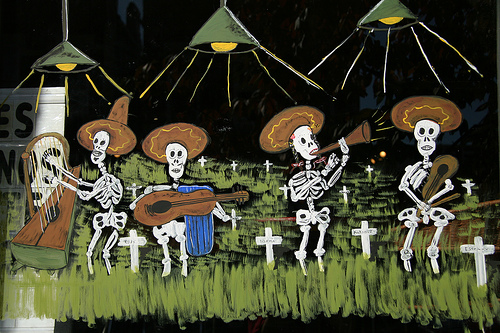Day of the (totally secular) Dead
 Year after year, the Divine Mrs. M.Z. Hemingway has -- as our resident liturgical Lutheran -- played the role of liturgical enforcer here at GetReligion. This is not a small role, since so many of the traditional holidays in various faiths (can you say Chanukah? Or Hanukkah?) have been turned into secular festivals or twisted into forms that have almost nothing to do with their historic meanings. This, of course, affects the mainstream news coverage of these holy days.
Year after year, the Divine Mrs. M.Z. Hemingway has -- as our resident liturgical Lutheran -- played the role of liturgical enforcer here at GetReligion. This is not a small role, since so many of the traditional holidays in various faiths (can you say Chanukah? Or Hanukkah?) have been turned into secular festivals or twisted into forms that have almost nothing to do with their historic meanings. This, of course, affects the mainstream news coverage of these holy days.
The normal GetReligion post focusing on these calendar issues features a two-part message. We tend to note that the typical sort-of-holiday story has a brief paragraph about the religious origins of the event, which is almost comically perfunctory, which is then followed by tons of details about the real, secularized celebrations.
What we are dealing with, most of the time, is a missed opportunity. Let me stress that our journalistic goal is not to ignore the secular reality, of course. We like to note that journalists can, from time to time, try to find out what happened to the religious rites, which often turns out to be an interesting and overlooked topic.
However, today's Washington Post contains something unique. Hang on.
The dateline, of course, is Mexico City.
Once upon a time, it was the Day of the Dead, but now it is the days of the dead.
A reverent, rural tradition of making picnics at the cemetery, of building a home altar of marigolds for the dearly departed? That continues.
But like Halloween in the United States, Dia de los Muertes in Mexico has become a bit of a free-for-all, a five-day weekend with parties and drinking, a smash-up where dad dons a Spider Man costume and mom dresses up as a naughty French maid -- to honor their ancestors, of course. It’s more pop, more pagan and more commercial. There’s even some trick or treating, which would have been unheard of a decade ago.
OK, the word "reverent" offers a hint of what's missing.
I kept reading, waiting for the obligatory paragraph that would say something like this:
The celebration takes place on November 1st and 2nd, in connection with the Catholic holidays of All Saints' Day (November 1) and All Souls' Day (November 2).
But there was no obligatory background paragraph at all. None. Zip. Zero. Nada. Niente.
Now it can be argued that this Post story is really about some of the giant folk-art festivities that now surround the Day of the Dead. Yet the story opens with the reality that what was once a singular celebration has exploded into something larger. The innovation, of course, is that the story tells the reader (a) absolutely nothing about the sacred origins of this secularized holiday, (b) absolutely nothing about the true meaning of the events and (c) absolutely nothing about what is left of the liturgical celebrations of the real holy days (which one must assume still have some minimal meaning for practicing Catholics in Mexico).
You think? Let me stress that I know the story is about the secular events.
I get that. The question for me is whether the reader can make any sense of these secular rites without know at least a little bit about the sacred rites that came first. Is there no connection, today, between the symbols surrounding the millions of people in Mexico's streets and the hundreds of thousands gathered at altars?
Maybe there could be room for one sentence? I'm not asking for a whole paragraph or a sidebar or anything really idealistic.
Just saying.